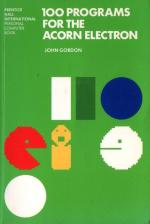
Elbug
 1st May 1984
1st May 1984
Author: Mike Williams
Publisher: Prentice-Hall International
Machine: Acorn Electron
Published in Elbug #6
This book, and cassette of the same title, can be purchased together or separately. 100 programs in a lot of computing in either format, but is it value for money? Mike Williams looks at this well-produced package and reports.
100 Programs For The Acorn Electron
The book contains a listing of each program which is clearly printed (unlike many computing books), with many instructions indented to clarify the structure of the program. Each program is accompanied by brief notes on the use and design of the program in question. The binding of the book made it very difficult (in fact impossible) to keep the book open at any listing, so that typing in any program was very much a one-handed and somewhat difficult task.
The cassette is well packaged to look like the book, and comes complete with a 32-page booklet containing notes on each program, very similar to those in the book. The only omission here is the book's list of contents which conveniently classifies the programs under various headings, and a general introductory chapter.
With 100 programs on offer, clearly the emphasis is on quantity, rather than quality, and consequently many of the programs are quite short. The cover a wide range including games (of course), business and home applications, mathematics and science applications and graphics examples. I believe that there are too many mathematical examples for the typical Electron user, and in contrast, there is insufficient coverage of string and text handling. This perhaps reflects the author's academic background, but even so, current ideas on the teaching of programming have long since moved on from the idea of the computer as a number machine.
The program descriptions, and indeed even the instructions for their use in some cases, are often frustratingly short in the information provided. Many of the program should really be considered as basic routines which the reader could integrate into a more polished program. As such, this collection could form an invaluable resource, particularly for the novice programmer. In view of this, I feel it is unfortunate that the notes accompanying many of them are so short, with often inadequate explanation of how the program works.
Despite some of the criticisms that I have made above, I am sure that many Electron owners interested in learning more of programming will find much of interest in these programs. Either book or cassette on their own would be sufficient, the former giving the advantage of printed listings for reference, the latter the convenience of direct cassette loading. Few people will quibble at programs costing a mere 7p (book) or 11.5p (cassette) each, though I do believe that half the number of programs and twice the explanation would have provided a more useful publication. But then, I suppose, the title wouldn't have been quite so eye-catching!
Scores
Acorn Electron Version| Overall | 73% |


